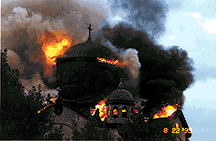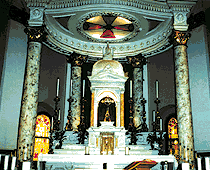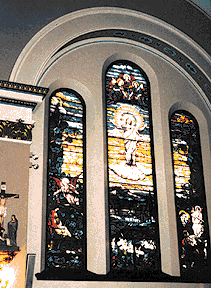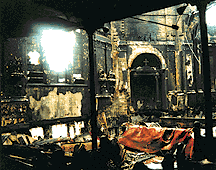-trans.gif) |
 |
-trans.gif) |
 |
Midwest Today, Summer 1996

 People of different religious beliefs were
known to visit and cherish this Byzantine cathedral. There was
something about the light, streaming in through the magnificent
stained glass windows, that cast an ethereal glow. In a hectic
and troubled world, this beautiful church provided a rare setting
for meditation, inspiration, and prayerful repose.
People of different religious beliefs were
known to visit and cherish this Byzantine cathedral. There was
something about the light, streaming in through the magnificent
stained glass windows, that cast an ethereal glow. In a hectic
and troubled world, this beautiful church provided a rare setting
for meditation, inspiration, and prayerful repose.
Fire departments from 20 communities as far as 50 miles away responded
to the blaze, which soon enveloped the limestone structure, piercing
its copper dome, and radiating heat so intense it melted the helmets
of fire fighters who opened the front door. Police had to shoot
out portions of the stained glass windows to get fire hoses inside.
Before setting the blaze, Willard had mailed letters to two bishops
and a Des Moines TV station, claiming credit for his actions.
Prior to his arrest, he even held a news conference to boast of
his deed.
Willard was ultimately convicted of arson and perpetrating a hate
crime.
Now, the news is filled with reports of other church burnings,
in a national tragedy that has united persons of all faiths and
political persuasions.
The burnings of predominantly African American churches occur
against what investigators say is a backdrop of widespread arson
against houses of worship of all kinds, including white churches,
mosques and synagogues.
As of press time, there had been 40 suspicious fires at black
churches in the last 18 months. During the same period, there
were 23 suspicious fires at predominantly white churches.
The Bureau of Alcohol, Tobacco and Firearms (ATF) has opened investigations
of 156 church fires, both black and white, nationwide since October
1991.
The fires have been closely followed in the Christian press for
months, but hadn't really made it into the mainstream media until
recently. Now the fires have become a Washington story, thanks
to House hearings and President Clinton's interest.
Part of the reason for the lack of national attention up to now
is that the congregations of the destroyed churches are no one's
natural constituency. The churches are scattered and belong to
no single denomination; many are independent. Most are small and
located in poor, rural areas.
Who's Responsible?
Although few arrests have been made, those charged with burning
down black churches in the South are generally white, male and
young, usually economically marginalized or poorly educated, frequently
drunk or high on drugs, rarely affiliated with hate groups, but
often deeply driven by racism, according to investigators.
 Members of one group told police they picked churches because
they were easy targets, isolated and empty.
Members of one group told police they picked churches because
they were easy targets, isolated and empty.
But in other instances, religious or racial hatred clearly was
the cause. In a fire that destroyed the Inner City Church in Knoxville,
TN., one ATF investigator said the arsonist(s) put a lot of time
and effort into the crime. "We found accelerants. We found
numerous Molotov cocktails. We found gunpowder. We found gasoline
cans and numerous other items of evidence at the scene,"
said Dick Garner of the ATF.
A few days after the fire, a couple of local businesses received
leaflets saying, "1996 shall be the year of white triumph
and justice for the master supreme race."
The leaflets also claimed that integrated communities, schools
and churches would no longer be tolerated.
Already more than $100,000 has poured in to rebuild the church,
thanks in part to the celebrity of their associate minister, professional
football star Reggie White of the Green Bay Packers.
An Angry Backlash
Bob Herbert of The New York Times wrote that "it
is important to keep in mind that we are not dealing here with
spontaneous combustion. The fuel for these fires can be traced
to a carefully crafted environment of bigotry and hatred that
was developed over the past quarter-century."
But unlike the 1960s, when the white evangelical church in the
South worked against the civil rights movement and misquoted Scripture
to justify it, today Southern white Christians have embraced their
black brethren.
At their annual convention recently, Southern Baptists, the nation's
largest Protestant denomination, passed a resolution condemning
the arsons, took up a special offering for the burned churches,
and volunteered the services of members to help in the rebuilding.
The politically liberal National Council of Churches has also
been in the forefront. It has set up an appeal for $2 million
to help rebuild the churches, many of which are uninsured or under
insured.
One Evil Man's Obsession
In the Stuart church fire, convicted arsonist Charles Willard
was obviously motivated by hate. He despised the Pope and claimed
that the Catholic church was "rich, fat, bloated, irrelevant
and anachronistic myth."
 Taking the witness stand on his own behalf, Willard revealed that
he had visited the church in Stuart on several occasions and knew
it was not secure. He chose to burn it precisely because it was
so beautiful. He drove from Des Moines to Stuart with gasoline
containers, which he concealed under layers of clothes and placed
in a shopping cart he found in the church. He said he doused the
upstairs and basement of the building, and tossed lighted matches
to ignite the conflagration. He then left and drove around the
block. But when he didn't see smoke, he returned and added more
fuel to the flame -- so much so that there was an explosion, ("it
went off like a canon," he recalled), which knocked him down.
Taking the witness stand on his own behalf, Willard revealed that
he had visited the church in Stuart on several occasions and knew
it was not secure. He chose to burn it precisely because it was
so beautiful. He drove from Des Moines to Stuart with gasoline
containers, which he concealed under layers of clothes and placed
in a shopping cart he found in the church. He said he doused the
upstairs and basement of the building, and tossed lighted matches
to ignite the conflagration. He then left and drove around the
block. But when he didn't see smoke, he returned and added more
fuel to the flame -- so much so that there was an explosion, ("it
went off like a canon," he recalled), which knocked him down.
In a long, rambling and at times incoherent fashion, Willard spewed
anti-Christian venom, endorsing instead the so-called Book of
Thomas and "Q" or Quelle. He said the gospel writer
Paul had created the Christ myth.
Willard bragged that he could have locked the doors and burned
the church on a Sunday morning when it was full of people, but
said that was not his style. He declared "I am a martyr"
for my cause.
In her concluding remarks to the jury, Willard's court-appointed
attorney, Beverly Wild of Guthrie Center, Iowa, acknowledged that
Willard was a complicated man who was hard to understand. She
said her client had made a statement that was an expression of
his free speech. "He burned down a church," she told
the jurors. But Wild questioned whether the crime was committed
because of religion. She asked, "How could he spend hours
studying religion if he hates it so much?"
The jury found Charles Willard guilty as charged.
The Spiritual Implications
Once God spoke out of a burning bush. He wouldn't let the fire
go out until Moses heard what God was saying.
There was a pillar of fire that lead the children of Israel through
the darkest night of 40 years of wandering.
In the book of Jeremiah, God tells Jeremiah to speak a word of
prophecy and have it written. It took a year to write 23 years
of prophecies, then God allowed the King to burn it up. But God
spoke to Jeremiah and said, "Take another scroll, and write
it down."
Speaking on "The 700 Club", The Rev. Carlton Pierson
commented, "The burning of the churches is not the end. We
simply take another scroll, and we build again, we build better.
We don't bank on the bitterness of the event. We see what God
is saying beyond that. There is some judgment, there's some fire,
there's some purging.
"This is a spiritual thing. We wrestle not against flesh
and blood, but against principalities. What the devil meant for
naught, God is going to turn it for our good."
| Click Here To Recommend This Story To A Friend |
Back to the top